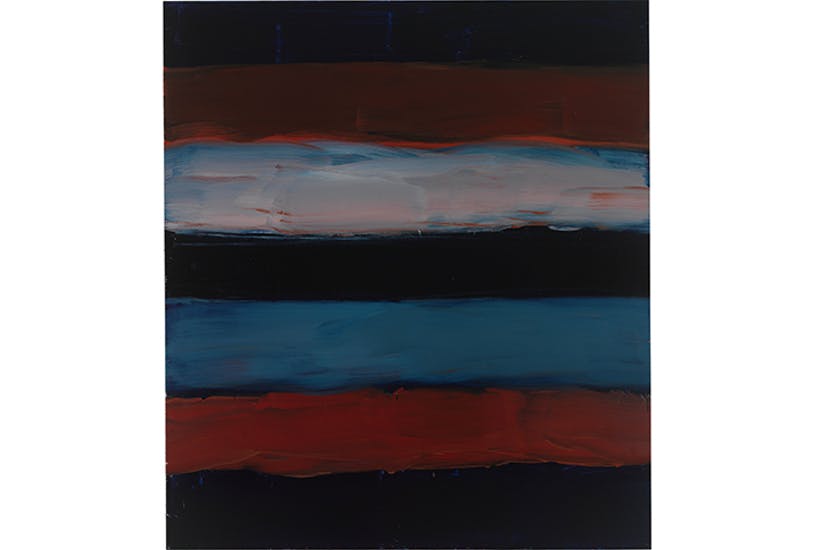
A beautiful exhibition of a magnificent painter: Sean Scully at the National Gallery reviewed

Sean Scully once told me about his early days as a plasterer’s mate. At the age of 17 he was helping a craftsman who would often accidentally drop a good deal of plaster on his youthful assistant’s head, especially after a midday break in the pub. Scully spent his own lunchtimes differently. He would roar on his scooter to the Tate Gallery, and spend the time staring at a single picture: ‘The Chair’ by Vincent van Gogh.
That picture is one of two reference points in Sea Star, his beautiful exhibition at the National Gallery. Scully pays homage to it in two groups of three paintings, entitled ‘Arles Abend Vincent’ and ‘Arles Abend Deep’. Neither looks much like a chair; the panels resemble, if anything, sections of a wall (if not a plastered one). Scully has, in fact, taken a series of photographs of dry stone walls on the island of Aran. The walls are like a puzzle — some stones vertical, some horizontal, wider or narrower.
The ‘Arles Abend’ paintings are similar, except that they are built out of rectangles of loosely brushed, sumptuously rich colour. That’s something perhaps he learned from those lunch breaks in front of Van Gogh. The physical presence of a paint-stroke is something that can’t be replaced, he told me, containing as it does ‘the thinking, the feeling and the making, all compressed into a single action: a kind of low-relief sculpture of what happened’.
The wide brush marks give visible energy to Scully’s works — sweeping this way and that, here more agitated, there calmer. This movement interacts with the colour-chord of each picture — ochres, dark crimsons and olive greens in the case of the ‘Arles Abend’ pictures.
Encountering a room of Scullys you might think: ‘Oh, a lot of stripes and squares’. But if you look at one for a while it takes you over. Like the teenage painter spending his lunch hours with Van Gogh, you could stand and look for ages.
More recently Scully has fallen for a late Turner — ‘The Evening Star’ (about 1830) — which is hung in the exhibition (Van Gogh’s ‘Chair’ is upstairs in the main galleries). This is, at first glance, an arrangement of horizontal bands of colour which resolve into beach, ocean, cloud and a sky just changing from day to night.
Scully’s pictures don’t translate into landscape that directly. He remains on the non-figurative side of the border between abstraction and representation — but quite close to the frontier. His magnificent ‘Land-line Star’ (2017) remains a sequence of stripes, stacked above one another — blue, black, dark red plus one an indescribable whiteish, pinky, blue-tinged zone that seems to ripple and crackle. But still it is a bit like looking at a moving river or the waves of the sea.
Scully moved from plastering to painting in the early 1970s just as painting — especially abstract painting — was going out of style. He has consequently spent a creative lifetime not quite in fashion, which may be why it’s only now in his seventies that it’s becoming apparent what a terrific artist he is.
Being out of step with what art history was supposed to be doing has been the fate of many important painters. It befell Leon Kossoff who, a generation older than Scully, emerged only to disappear from view while abstraction ruled in the 1960s. Despite a Tate retrospective in the 1990s, Kossoff has still not quite received his due.
He is a truly great painter, but one whose work has not been seen enough in recent years. For that reason the current exhibition at Piano Nobile (96/129 Portland Road, W11) is especially welcome. Kossoff occupies a territory just on the figurative side of that frontier with abstraction. Each of his picture starts with what he has called ‘exciting visual encounters’ — either with one of his small circle of familiar models or a bit of London townscape, frequently in the environs of Willesden where he has long lived.
The places Kossoff selects would not strike everyone as exciting. But he makes you feel they are. A charcoal and pastel drawing of the railway lines at ‘Willesden Junction’ (1962) has the exhilaration and spatial expansion of Turner’s alpine scenes.
His oils are painted on boards, which has an effect on the way they look. Scully favours aluminium or linen, on which the pigment flows smoothly. In contrast Kossoff’s paint is slashed and scooped across the wood, building up in gnarled masses with a splatter of flying drips. ‘Christchurch, Spitalfields’ (1989) takes off like a rocket, a red brick school building trembling like a vision beneath a lowering sky. It is a great pleasure to see such paintings by natural light in the London townhouses which Piano Nobile occupies: the perfect environment for Kossoff. This show, like the Scully, is highly recommended.